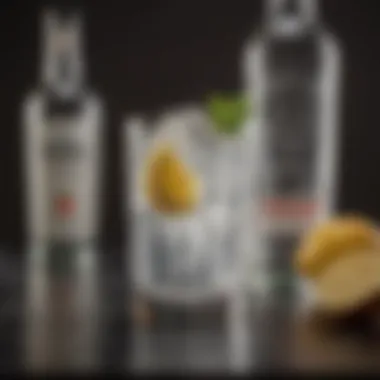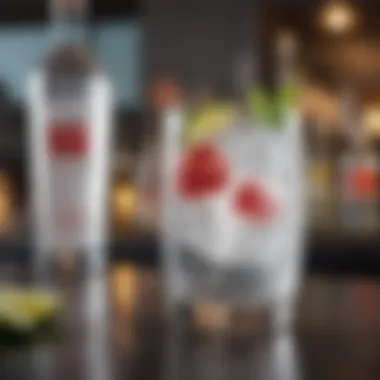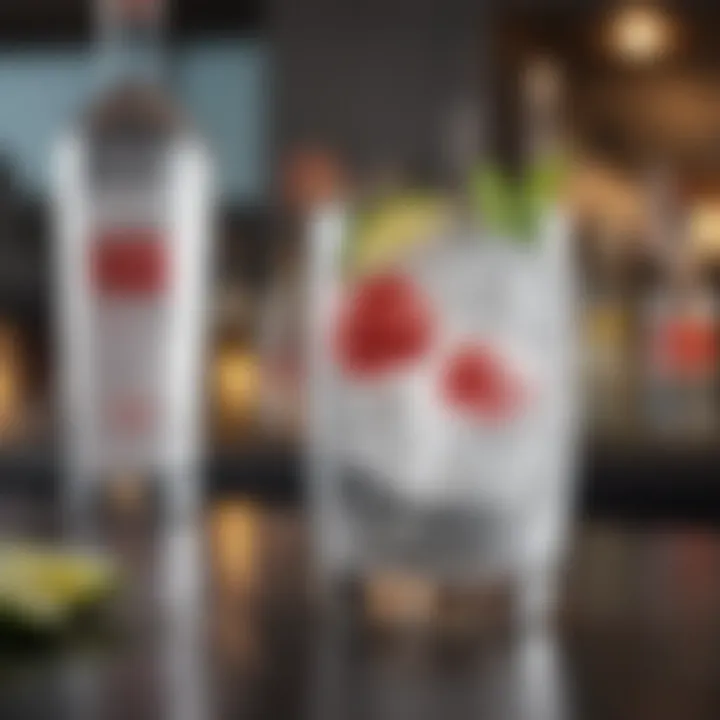Vodka Soda: A Deep Dive into Its Essence and Appeal


Intro
Vodka soda, that classic staple in bars and kitchens across the globe, speaks to a lot more than just simplicity and refreshment. It's a drink that has woven itself into the fabric of modern socializing. Few drinks can match its versatility or sheer ease of preparation.
Recipe Overview
- Recipe name: Vodka Soda
- Brief description of the dish: A simple yet elegant concoction, a vodka soda consists primarily of vodka poured over ice and topped with soda water. It’s often garnished with a wedge of lime or lemon for that little extra zing. This drink is not only refreshing but also acts as a blank canvas for individual preference, accommodating different flavors and twists.
Ingredients List
Main ingredients
- Vodka: The spirit at the heart of the drink. Its purity and flavor can shift dramatically based on the brand and ingredients used in the distilling process.
- Soda Water: The effervescence that elevates the vodka, giving it a light, bubbly finish.
Optional ingredients
- Lime or Lemon Wedge: For a splash of citrus that balances the drink perfectly.
- Fruit Garnishes: Consider cucumber, berries, or even herbs like mint or basil for an interesting twist.
- Flavored Vodka: From berry to vanilla, flavored vodkas give a different character to the traditional vodka soda.
Just as there are no hard and fast rules when mixing a cocktail, vodka soda presents a world of possibilities. Its straightforward composition doesn’t just make it easy to mix, but also gives rise to countless variations that cater to diverse palates and dietary preferences. This delightful mix is widely accepted and remains a go-to choice for many, embodying the balance between casual and sophisticated.
Preamble to Vodka Soda
In recent years, vodka soda has cemented its status as a staple in many social gatherings and bars around the world. This seemingly uncomplicated drink is much more than just a mix of vodka and soda water; it carries with it a blend of history, cultural significance, and a unique flavor profile that can appeal to both casual drinkers and connoisseurs alike.
Understanding the essence of vodka soda allows us to appreciate both its place in contemporary drinking culture and its fundamental qualities, like simplicity and versatility. This drink exemplifies how minimal ingredients can create something enjoyable, making it a favorite choice for various occasions and personal preferences.
Defining Vodka Soda
At its core, vodka soda is a thirst-quenching cocktail that consists of two primary components: vodka and soda water. The spirit offers a neutral backbone that pairs exceptionally well with the effervescence of soda, creating a refreshing experience.
Components:
- Vodka: A distilled alcoholic beverage known for its purity and mild flavor. Often made from fermented grains or potatoes, the vodka’s quality can significantly influence the drink’s overall taste.
- Soda Water: This bubbly base often brings a light and crisp sensation to the cocktail. Its carbonated nature makes the drink both refreshing and invigorating.
The drink may be served with a twist of lime or a splash of fruit juice, enhancing its profile. However, the beauty lies in its unadorned state, allowing enthusiasts to enjoy the uncomplicated blend.
Historical Context
The roots of vodka soda can be traced back to the 20th century when vodka began gaining traction outside of Eastern Europe. Initially embraced in Russian and Polish traditions, vodka became a significant part of cultural practices involved with celebrations and socializing.
As the cocktail culture evolved, bartenders began experimenting with different mixers. It was during this exploration that soda water emerged as a popular companion to vodka, balancing the spirit's strength with a light fizz.
Drinking vodka soda eventually became synonymous with modern social gatherings, particularly in bars and clubs. Its straightforward preparation and the customizable nature made it appealing, especially for those looking to indulge without overwhelming their palate.
Cultural phenomena, such as the rise of fitness trends and health-conscious drinking, further boosted vodka soda's popularity. This cocktail is often viewed as a lower-calorie option compared to other mixed drinks, making it a favored choice among health enthusiasts.
In essence, vodka soda's journey from traditional Eastern European roots to global cocktail menus underscores its evolution and cultural resonance. Its enduring presence in modern drinking culture is a testament to its adaptability and simplicity.
The Components of Vodka Soda


When discussing a beverage as simple as vodka soda, one may wonder why its components warrant a detailed examination. Yet, it is precisely the interplay of its core ingredients that crafts the drink's hallmark fizziness and flavor. Understanding these elements is crucial not only for appreciating the drink itself but also for navigating the broader landscape of contemporary beverage culture. Each component contributes uniquely to the overall experience, be it the distinct character of the vodka or the effervescence of the soda water.
Vodka: An Overview
Origin and Production
Vodka has a storied history, dating back to its roots in Eastern Europe. The earliest documented production can be traced to the 8th or 9th century, with regions like Russia and Poland laying claim to the spirit's origins. Traditionally, vodka is distilled from fermented grains or potatoes, though modern varieties may originate from a diverse array of ingredients, including rye, corn, and even fruit. The key characteristic of vodka production is its purity. The distillation processes employed aim to reach a high level of ethanol concentration, reducing impurities for a clean finish. This purity is essential for vodka soda, where the drink relies heavily on the vodka's neutral profile to allow for the soda's flavors to come through. However, it is worth noting that there’s a subtle art to making vodka. The methods can affect not just flavor, but also the mouthfeel—some brands excel in giving a smoother experience, while others may have a sharper edge.
One unique feature of vodka production is the filtration process, often involving activated charcoal or other materials to further refine the spirit. This adds an elitist element to premium brands, calling attention to their craftsmanship and quality. For enthusiasts, choosing a vodka with a noteworthy production story can add an extra layer of enjoyment.
Varieties of Vodka
When it comes to vodka, variety is the spice of life. Not every vodka is created equal, and understanding the distinctions can add depth to one’s enjoyment of vodka soda. There are several classifications: plain, flavored, and premium vodkas. Plain vodkas are often used for cocktails, while flavored varieties—such as citrus or berry—can significantly enhance the profile of a vodka soda.
The key characteristic of these varieties lies in their flavor profiles and complexities. Some drinkers may prefer a classic, clean vodka as a backdrop for their soda, while others may seek out infused versions that contribute richness to the drink's experience. A unique aspect of flavored vodkas is their capacity to meld seamlessly with soda, sometimes even replacing mixers entirely.
It's equally essential to note the regional influences on vodka varieties. Different countries may emphasize varied ingredients or methods, leading to tastes that are markedly distinct. This aspect can indeed be quite beneficial for those exploring vodka soda; it opens up avenues for mixing and matching to suit personal tastes. However, it can also be a double-edged sword, leading to potential confusion about which one to choose for the ultimate blend.
Soda Water: The Catalyst
Types of Soda Water
Soda water’s role in vodka soda is not merely as a filler—it's a crucial catalyst in the flavor dynamics of the drink. There are various types of soda water available in the market, including sparkling water, tonic water, and club soda. Each brings something different to the table. Sparkling water, for instance, offers a gentler fizziness, while club soda often has added minerals, contributing slightly to the flavor profile.
The key characteristic to highlight here is the level of carbonation and how it interacts with vodka. The effervescence stimulates the palate, enhancing the drinking experience by providing a fresh, crisp counterbalance to the vodka's alcoholic notes. This natural fit is part of what makes vodka soda a staple choice in bars and social settings. Consumers can readily find different brands that vary in fizzy intensity, allowing for personalization based on preference. Yet, the availability of varieties can sometimes lead to confusion about what works best with specific vodkas.
Role of Carbonation
Carbonation plays a vital role in not just the sensation but also the overall perception of vodka soda. The effervescence contributes to a feeling of lightness, which can make the drink feel less heavy compared to straight spirits. This characteristic is essential, as it caters to those who may be hesitant about the strong mouthfeel of straight liquor.
The key aspect of carbonation is its ability to elevate the flavors within the drink. The bubbles act as tiny vehicles, transporting aromas and flavors to the olfactory senses, which enhances the overall sensory experience. In fact, the right level of carbonation can turn what might be a mundane drink into a refreshing delight on a hot day. However, too much fizz can overwhelm delicate flavors; hence, the choice of soda water is quite significant in achieving the right balance.
The blend of vodka’s purity and soda water's refreshing fizz creates a drink that embodies simplicity while maintaining a nuanced experience.
To sum it up, the components of vodka soda intertwine in ways that elevate the overall experience. The choice of vodka can introduce varying flavor notes, while the soda water enriches the texture and sensation of every sip. As we continue to peel back layers in this exploration, understanding these elements sheds light on why vodka soda has earned its rightful seat at the table of popular beverages.
Flavor Profiles and Pairing
The flavor profiles of vodka soda are more than just a simple interplay of spirits and mixers. This section explores the nuances that make this drink not only a staple in many social settings but also a versatile canvas for flavor exploration. The joy of vodka soda comes from how it can adapt to various tastes and occasions, making it a preferred choice for both casual get-togethers and upscale events. By understanding these flavors and pairings, one can elevate their vodka soda experience.
Taste Dynamics
Balancing Alcohol with Fizziness
The balancing act between alcohol and fizziness is a key characteristic of vodka soda. The smoothness of vodka, mixed with the effervescence of soda water, creates a refreshing drink that isn’t too overpowering. This balance is attractive because it allows for easy sipping, making it suitable for long conversations or evenings out without overwhelming the palate. The carbonated nature of soda not only adds a fizzy punch but also helps to enhance the flavors of the vodka. This synergy makes vodka soda a popular choice among those seeking both refreshment and a mild buzz.
However, it’s essential to consider that not all vodkas interact with soda water equally. Some might become lost in the fizziness, while others can clash with the bubbles. This highlights the importance of selecting a vodka that complements the carbonation, ensuring a pleasant drinking experience.
Influence of Ingredients


Ingredients play a crucial role in shaping the flavor experience of vodka soda. From the type of vodka used to the quality of the soda water and any additional flavorings, each element contributes to the overall taste profile. Premium vodkas, like Grey Goose or Belvedere, often bring a creamier mouthfeel and subtle flavors that shine through the clarity of the soda.
Moreover, the choice of soda water—plain, tonic, or flavored—can significantly alter the drink’s profile. The added nuances might enhance or mute certain notes in the vodka, leading to a dynamic tasting experience. Using a lemon or lime wedge, for instance, can provide a zesty brightness that perfectly balances the drink’s components. However, being mindful about ingredient selection is vital, as inferior mixers can overshadow the vodka’s quality, dampening an otherwise delightful experience.
Innovative Mixes
As the cocktail culture evolves, vodka soda has embraced innovative mixes that broaden the scope of traditional flavors. This modern twist not only satisfies adventurous drinkers but also puts a creative spin on the classic drink.
Infused Vodkas
Infused vodkas have gained traction in recent years, offering bold flavors that kick the standard vodka soda up a notch. These are vodkas that have been imbued with various fruits, herbs, or even spices, creating a depth that transcends the original spirit. Infused options, such as cucumber vodka or berry-infused varieties, can add a layer of complexity to the drink, enticing those curious to try something new.
The beauty of infused vodkas lies in their ability to reveal unique profiles that complement the soda. This innovative choice expands not just the flavor options but also how vodka soda fits into different drinking occasions, catering to a broader spectrum of preferences. Yet, using such vodkas might require adjustments in the amount of soda or other garnishes to ensure the flavor doesn’t become too lost in the mix.
Flavoring Options
Flavoring options extend beyond infused vodkas, allowing enthusiasts to customize their drinks even further. Adding fresh herbs, like mint or basil, or a splash of fruit juice can result in an entirely different tasting experience. These choices can provide freshness or additional flavor that invigorates the basic vodka soda formula.
The flexibility of flavoring options makes vodka soda an attractive canvas for mixologists and casual drinkers alike. However, too many flavors might lead to a muddied taste. A careful balance is key—strategically selecting flavorings that enhance and meld with the vodka rather than distract from it.
The art of crafting the perfect vodka soda lies in the harmonious connection between flavors, where balance reigns supreme.
Cultural Significance of Vodka Soda
Vodka soda represents much more than a simple drink; it serves as a cultural artifact reflecting social dynamics, preferences, and rituals shaping modern drinking landscapes. With its roots embedded in diverse cultural practices, the cocktail has become a staple in bars and households across the globe. Understanding its significance encompasses exploring social settings, traditions of consumption, and the drink’s ability to adapt to various contexts.
Vodka Soda in Social Settings
Preferred Occasions
When it comes to specific occasions, vodka soda shines brightly across a variety of social gatherings. It’s frequently found at parties, casual get-togethers, and even formal events, cementing itself as a flexible option that doesn’t alienate palates. This versatility plays a crucial role in its acceptance; whether at a barbecue with friends or the swankiest of soirées, vodka soda fits right in.
A unique characteristic of these occasions is the drink’s minimalist approach. Its uncomplicated mixture makes it easy for hosts to prepare while ensuring guests find something refreshing without being overwhelmed by complex flavors. This aspect of simplicity plus adaptability reveals why vodka soda remains a popular choice. However, its lack of flavor complexity can also be seen as a limitation — one may argue the drink offers little excitement compared to cocktails embracing a spectrum of tastes.
Symbol of Modern Drinking Culture
Vodka soda encapsulates the essence of modern drinking culture. It’s a go-to choice for those who prioritize health and moderation yet still want social interaction. The drink's image has evolved over recent years, frequently appearing in Instagram posts and trendy bars, establishing it as synonymous with a balanced lifestyle.
Its key characteristic lies in how it symbolizes a minimalist yet sophisticated approach to drinking. People are increasingly leaning towards less complicated cocktails as they foster a more conscious consumption atmosphere. Still, one must recognize the potential disadvantages; some may see it as lacking character or creativity, particularly against more elaborate cocktails.
Global Variations and Practices
Regional Variants
Around the world, vodka soda manifests in various forms, tailored to local palettes and traditions. For instance, in Russia, one might find variations that incorporate a traditional kvass flavor, while in Mexico, soda may be swapped out for a tangy mineral water to introduce a unique effervescence. This regional diversity highlights vodka soda's adaptability and how it can incorporate local customs into its identity.
The allure of these regional variants often rests in their unique flavor enhancers, offering a twist to the classic drink. However, these adaptations can also be double-edged swords; some may feel that altering a classic recipe detracts from the vodka soda's true essence.
Traditions Surrounding Consumption


Each culture can offer its unique spin on vodka soda that revolves around traditions and social rituals. In many Eastern European countries, for instance, vodka is often consumed during toasts marking significant milestones or celebrations. This collective act of drinking helps foster camaraderie, binding people together through shared experiences.
The significance of these traditions lies in their ability to enhance the communal aspect of drinking—a hallmark of vodka sodas’ appeal. Yet, the challenge arises when these practices collide with modern trends that lean towards individualism; as more people favor personal preferences, traditional practices may start to fade or transform.
Health Considerations
Understanding the health aspects of vodka soda is essential for those who may enjoy this popular beverage. While the drink is often lauded for its simplicity and refreshing nature, it is equally important to examine the implications of its consumption on health. This section will delve into the caloric content, nutritional aspects, and the necessity for moderation when enjoying vodka soda. Comprehending these elements can aid individuals in making informed decisions surrounding their drinking habits.
Caloric Content and Nutrition
When it comes to vodka soda, one might assume it's a low-calorie option compared to many cocktail alternatives. Generally, the caloric content largely comes from the vodka itself and external mixers if added. Pure vodka contains about 64 calories per shot (1.5 oz), while soda water adds virtually no calories to the mix. Therefore, a basic vodka soda will hover around 64 calories, which is quite admirable considering other cocktails can escalate to 200 or even 300 calories.
However, when discussing caloric content, it is crucial to consider the alcohol-by-volume (ABV). Regular vodka typically has an ABV of 40%, which can influence how a person perceives weight gain or overall health effects. Drinking high-calorie mixers or flavored vodkas can also increase the calorie count significantly.
Here's a brief breakdown of caloric content considerations:
- Standard vodka soda (1.5 oz vodka + soda water): ~64 calories
- Flavored vodka varieties: May contain additional sugars and calories
- Mixers like juice or tonic: Often high in calories and should be consumed sparingly
By remaining aware of these figures, individuals can better assess how vodka soda fits into their overall diet.
Moderation and Responsible Drinking
In a world buzzing with social gatherings and celebrations, it's easy to lose sight of moderation. Enjoying vodka soda in a responsible manner is key to maintaining not just health, but also positive social interactions. Too much of even a low-calorie drink can lead to a range of issues — from impaired judgment to potential negative health effects.
Here are some points to keep in mind regarding moderation:
- Set personal limits: Know how much you plan to drink before heading out; this helps in avoiding impulsive decisions.
- Stay hydrated: Alternating between vodka soda and water can keep you feeling refreshed and minimize the aftereffects.
- Listen to your body: Recognize when you’ve had enough. Alcohol can affect everyone differently, and what works for one person may not work for another.
"Moderation is not about deprivation. It's about balance and making choices that allow enjoyment without excess."
Practicing responsible drinking does not only protect one's health; it enhances social experiences, allowing individuals to engage better and enjoy their surroundings fully.
Finale
In this final part, we reflect on how vodka soda has carved its niche in the world of beverages. The drink's timeless appeal lies in its uncomplicated nature, which enables it to fit in various social contexts. Not only does it offer a refreshing respite from the hustle and bustle of daily life, but it also serves as a canvas for creativity, inviting variations and personalized twists.
Reflections on Vodka Soda's Endurance
Thinking about vodka soda's endurance isn't just about counting the bottles popped and glasses clinked. It’s about grasping why this drink has become a staple. Rooted in simplicity, vodka soda stands out amidst cocktails with elaborate preparations. It appeals to a broad spectrum of drinkers, from the casual socializer to the refined palate seeking a classic sipper.
Consider its understated elegance. The fusion of vodka's crispness with the effervescence of soda creates a delightful sensation. Vodka soda is like an old friend that you can call up at any time; it's dependable and never goes out of style. Moreover, the drink’s adaptability contributes significantly to its longevity.
- Simplicity: Few drinks are as easy to make. Only two main ingredients ensure that anyone can whip up a vodka soda, whether at a bar or at home.
- Cultural Shifts: Reflecting on changing norms, vodka soda has embraced health trends, seen as a lighter option. It caters to those seeking lower caloric content without skimping on taste.
- Socialization: Often enjoyed in a group setting, vodka soda fosters camaraderie. This cultural resonance makes it more than just a drink; it’s a shared experience, echoing the laughter and stories that come with it.
"A drink can bring people together, creating moments that linger far beyond the last sip."
Future Trends in Vodka Soda Consumption
Looking ahead, the trajectory of vodka soda appears promising. As drinkers become more adventurous, there are some noteworthy trends on the horizon.
One major trend likely to shape vodka soda's future is the increased interest in flavored vodkas. With the rise of artisanal distilleries, unique flavors are abundant, pushing drinkers to experiment and customize their drinks. Infusing vodka with unexpected botanicals, fruits, or spices opens up a world of pairing possibilities, creating conversations around what a vodka soda can truly be.
Moreover, the emphasis on health-conscious choices is gaining traction. Consumers are becoming more aware of ingredients in their drinks, driving a demand for organic mixers and naturally-flavored sodas. This focus on well-being aligns with vodka soda's image as the lighter cocktail alternative.
Additionally, advancements in sustainability within the beverage industry may influence the future of vodka sodas. There is an increasing push for eco-friendly bottles and local sourcing of ingredients, adapting the image of vodka soda to match today's environmentally-aware consumer.







